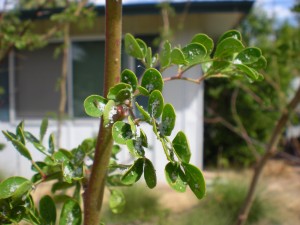

Psyllids begin showing up in the springtime and will hop around on different host plants has temperatures change. They are often confused with aphids due to the fact they are similar in shape, color and cause similar damage. The main noticeable difference between aphids and psyllids is aphids can easily be controlled by hosing off weekly, psyllids are not so easily controlled. They are closer to the leaf, leave crystal-like deposits (excrement) on the foliage that often acts as a protective shield. These barely-visible insects can be very devastating to a host. Arizona and honey mesquites can have new growth deformed for the season and cascalotes can be defoliated in a matter of weeks if not properly managed. Besides chemical treatments, you can help manage populations by limiting irrigation or trying not to over-water which can promote new succulent growth, which is attractive to the psyllid. Monitor for these little guys starting in February continuing into the summer months. They may go away for the hottest period of the summer (who wants to hang out on a leaf at 110?) but resurface again in the fall.